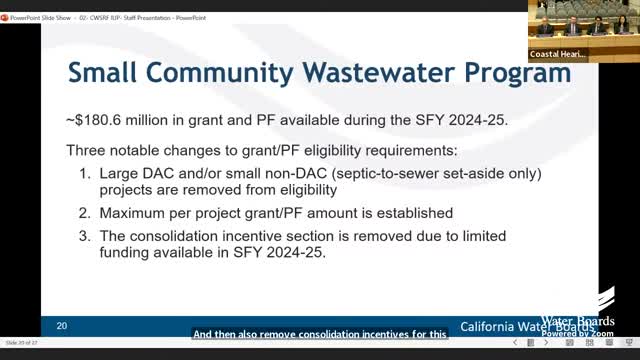Funding Crisis Threatens Vital Water Infrastructure Projects
July 03, 2024 | State Water Resources Control Board, Agencies under Office of the Governor, Executive, California

This article was created by AI summarizing key points discussed. AI makes mistakes, so for full details and context, please refer to the video of the full meeting. Please report any errors so we can fix them. Report an error »

In a recent government meeting, officials discussed the allocation of $200 million in funding for drinking water and wastewater projects, emphasizing the need for careful analysis and strategic planning in light of limited resources. The maximum grant amount proposed for projects is set at $15 million, with the possibility of increasing to $25 million under specific conditions if additional funds become available.
Deputy Director Joe Karkovsky highlighted that the funding is sourced from the greenhouse gas reduction fund, marking a shift from traditional general fund allocations. This new funding source necessitates a thorough examination of project eligibility and requirements, particularly for septic to sewer initiatives, which are crucial for public health and environmental protection.
Concerns were raised regarding the disparity between the high demand for septic to sewer projects and the available funding. Board member Morgan stressed the importance of these projects, noting their significant impact on groundwater quality and public health. The discussion revealed that while some large-scale projects are seeking funding upwards of $100 million, the current funding limits may hinder their full realization.
The meeting also touched on the need for further discussions regarding the distribution of funds, particularly in addressing the needs of historically underserved communities. Board member Firestone echoed these sentiments, advocating for a focus on environmental justice and the inclusion of areas that have long been excluded from investment.
As the board prepares for future discussions, the urgency of addressing the funding gap and the implications for community health and environmental sustainability remain at the forefront of their agenda. The outcome of these deliberations will be critical in shaping the future of water infrastructure projects across the state.
Deputy Director Joe Karkovsky highlighted that the funding is sourced from the greenhouse gas reduction fund, marking a shift from traditional general fund allocations. This new funding source necessitates a thorough examination of project eligibility and requirements, particularly for septic to sewer initiatives, which are crucial for public health and environmental protection.
Concerns were raised regarding the disparity between the high demand for septic to sewer projects and the available funding. Board member Morgan stressed the importance of these projects, noting their significant impact on groundwater quality and public health. The discussion revealed that while some large-scale projects are seeking funding upwards of $100 million, the current funding limits may hinder their full realization.
The meeting also touched on the need for further discussions regarding the distribution of funds, particularly in addressing the needs of historically underserved communities. Board member Firestone echoed these sentiments, advocating for a focus on environmental justice and the inclusion of areas that have long been excluded from investment.
As the board prepares for future discussions, the urgency of addressing the funding gap and the implications for community health and environmental sustainability remain at the forefront of their agenda. The outcome of these deliberations will be critical in shaping the future of water infrastructure projects across the state.
View full meeting
This article is based on a recent meeting—watch the full video and explore the complete transcript for deeper insights into the discussion.
View full meeting
